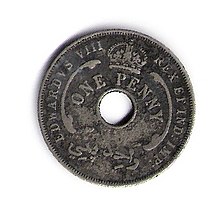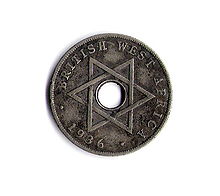West African pound
The West African pound ( English West African pound ) was a currency that was created by the British colonial power in 1907 for the areas of British West Africa and was temporarily adopted by the independent state of Liberia . The West African pound was later replaced by the currencies of the then independent states. It was equivalent to a pound sterling .
history
The West African pound was valid in the then British territories of what is now Nigeria , Ghana (then Gold Coast ), Sierra Leone and Gambia . From 1912 the currency was issued by the West African Currency Board . Liberia - although not a British colony - replaced its own currency, the Liberian dollar , with the West African pound as early as 1907. In 1943, the Liberians replaced the West African pound with the US dollar . The British part of Cameroon adopted the currency in 1916 after the area became British due to the early defeat of the Germans in the African scene of the First World War .
Denominations
Coins were issued in pieces of 1/10, ½, 1, 3 and 6 pence and 1 and 2 shillings. Banknotes came in 1, 2, 5, 10, 20 and 100 shilling units and as 1 and 5 pound notes.
Abolition of the West African pound
Between 1958 and 1968 the West African pound was abolished in the then independent African states and replaced by their own currencies:
| Country | Introductory year | New currency | Exchange rate to the pound |
|---|---|---|---|
| Ghana | 1958 | Ghanaian pound | 1 |
| Nigeria | 1958 | Nigerian pound | 1 |
| Cameroon | 1961 | CFA franc | 700 |
| Sierra Leone | 1964 | Leone | 2 |
| Gambia | 1968 | Gambian pound | 1 |


